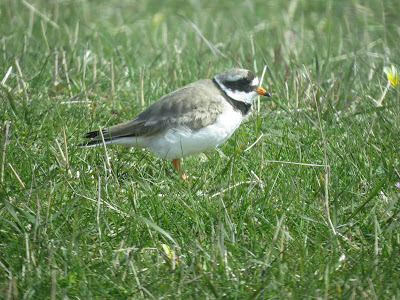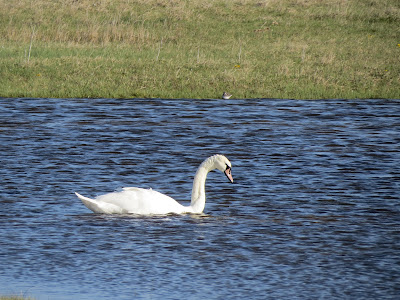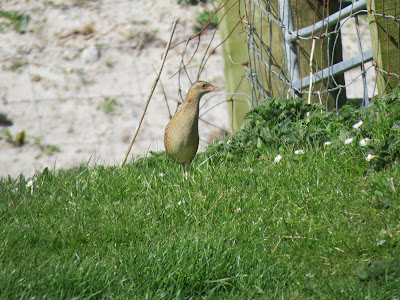You can see the tiny PHALOROPE just above the SWAN'S head
Sunday was the second day of the holiday and the first proper on the Uist islands. We set off fairly early and were driving through North Uist when a shout came:
'Phalarope!'
the mini bus screeched to a standstill.
There was a beautiful RED NECKED PHALOROPE, tiny, swimming out in the middle of the water. It was a female, because in a role reversal for birds, the females are more brightly coloured. It had a white patch under the bill, with a red throat. Amazingly a second bird arrived and after a brief struggle the original ran out winner. This record is the first returning bird of the year to the islands and a great, and lucky, find. The bird is an extremely rare breeding bird in the UK and always tricky to find on migration.
As we watched the birds we saw a SHORT EARED OWL flying over the back fields and a HEN HARRIER a bit further back. Today we saw three SHORT EARED OWLS and two HEN HARRIERS. We often got good views but they were mainly always seen from the mini bus, flying over an area of rough grass. The Uist Islands with their moorland landscape and lack of shooting estates are perfect for those species of birds and they were seen daily on the holiday.
Balranald was the target of the day, an RSPB reserve based round a headland in western North Uist. Its one of those reserves that blends into the countryside, not managed too intensively for wildlife, more in the traditional crofting way. As we approached the reserve we stopped every so often to look for CORNCRAKES, our target bird for the holiday, and as we did so we witnessed the sheer numbers of WADERS that were breeding in the wet grassland areas. It really was staggering with LAPWING, REDSHANK and OYSTERCATCHERS all there in large numbers.
There were already LAPWING chicks around at the moment, but we didn't see any CORNCRAKES on the approach. After the cold March the vegetation was a lot lower than it should be, not providing enough cover for the CORNCRAKES to lurk in. Yellow iris leaves were appearing in the wet areas which the CORNCRAKES love, those untidy areas that used to be part of farms down south and which are now unfortunately gone.
LAPWING chick
As we came to the reserve centre, a group of people were seen behind the visitor centre building. Rushing out we were told they had just seen a CORNCRAKE, but it had just disappeared. Getting cameras and scopes in position we waited and were rewarded when a CORNCRAKE poked its head out of some cover.
It then continued to walk out in the open in a small grassy field.
It then went and spent some time amongst some lobster pots and a cattle pen, maybe looking for a nesting area. The bird was a female. Nearby two male CORNCRKES were calling although we didn't see them. The call is reminiscent of its Latin name 'crex crex' like a scratchy frog sound, it was very atmospheric.
The CORNCRAKE then spent the next hour or so moving around in the open while we watched ten metres away.
Phil the tour leader said this was the best views he had ever had of the species, most years people get a brief view of a head moving through cover, or something similar, not one strutting its stuff out in the open. It was really a one in a life time view.
This was of course my first ever sighting of the species, because as a bird it is restricted to the Isles of Scotland. The kind of habitat they desire, overgrown damp places do not just exist anymore in England, farms are just too sterile down here, everything is so tidy.
At the same time a CORN BUNTING was singing from a post above the CORNCRAKE. Now these birds used to be common but are another casualty of the race to intensify as much land as possible into agriculture. They are now so rare that this remnant populations is considered a distinctive part of the crofting landscape and initiatives are in place to protect them.
After indulging in the CORNCRAKE we moved on further down the headland to look for another rare bird, this time a SEMIPALMATED SANDPIPER. The bird was reported online the day before, and as we were in the area became a target bird... ah the wonders of modern technology.
As we drove down we passed ancient crofting in the landscape, ploughing up the sandy fields, which created good habitat for waders including many, many RINGED PLOVERS, they absolutely loved this habitat and were found everywhere it was found in large numbers.
WHEATEARS on one of the ploughed fields
We walked down to the coast and amongst the sea weed strewn rocks were hundreds of WADERS, consisting mainly of DUNLIN, TURNSTONES and SANDERLING, all looking splendid in their summer plumage, with a couple of PURPLE SANDPIPERS amongst them.
The TURNSTONE had the most glorious summer plumage, looking like a harlequin
We caught the SEMIPALMATED SANDPIPER, standing out mainly because it was tiny - it was little stint size - and was in a pool right in front of us. It was fairly unusual in having no stand out summer plumage. It was very aggressive to the other waders, often chasing them off if they came too close. If this bird was in Norfolk or Suffolk there would have been huge queues to see this bird, but out here in North Uist...Just us. Anyway, another brown job from America and a life tick.
Three BAR TAILED GODWITS were in the area, and whilst we were watching them a dark morph ARCTIC SKUA flew over. This would be the first of a few we would see on the holiday, they would spend the time roaming up and down the coast, looking for some easy prey, never in too particular a hurry.
With some good birds under the belt, there were still enough hours in the day to catch some more. In particular there was a group of DOTTEREL hanging around. We parked up next to an area of cattle grazed machair, as usual full of RINGED PLOVERS. As we walked around a bit, two LITTLE TERNS flew over - rare nesting birds here - and eventually caught sight of a DOTTEREL. Beautiful birds, they are plovers that nest right on the tops of the highest mountains in Scotland. The bird might have been spooked by us and flew off to another area of the field where we found a second bird. A great sighting.
That was it for the day and we returned to the hotel.
Wow that was a bird filled day, full of some amazing once in a life time views. This is why I took this holiday for the chance of seeing things I wouldn't on my own and it proved worth it after today. And there were still some days left.

























































